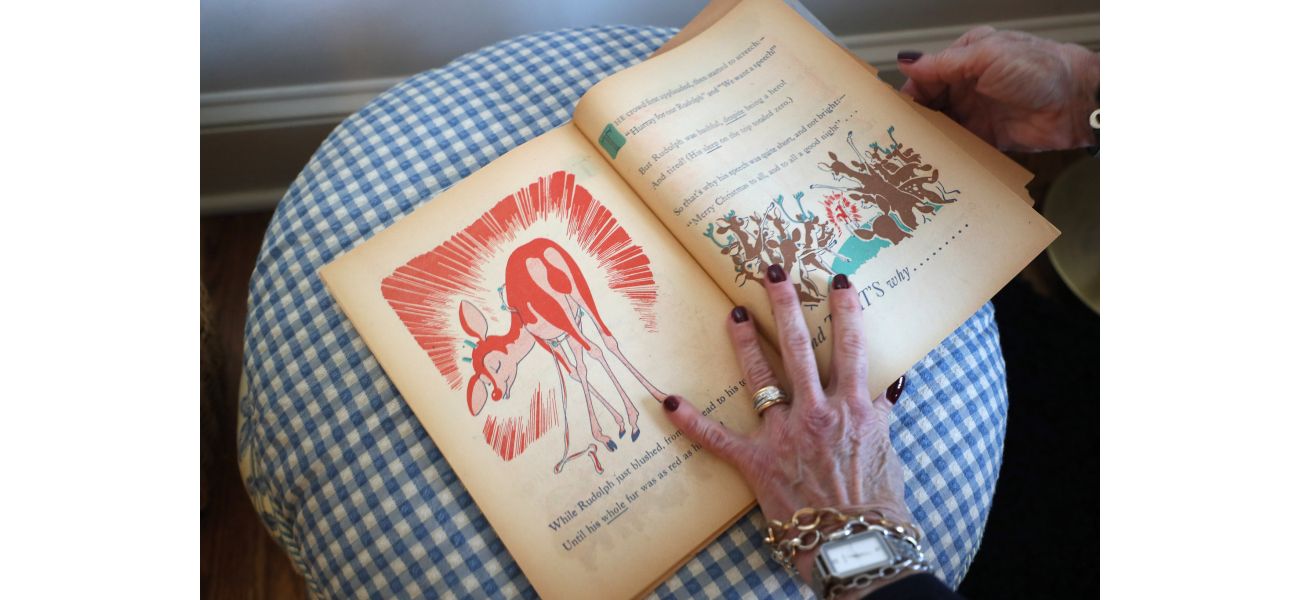The Chicago Tribune explores the origins of Rudolph the Red-Nosed Reindeer and its rise to becoming a beloved Christmas symbol.
Rudolph the Red-Nosed Reindeer was created to make money, but its creator used it as a chance to be bold in his writing, like the flying reindeer.
December 23rd 2024.

When Rudolph the Red-Nosed Reindeer came onto the scene, his creation was fueled by a desire to make money, much like Scrooge's greed in A Christmas Carol. However, the creator of this iconic Christmas character saw an opportunity to unleash his creativity and be as daring as the flying stag he had conjured up, with its dazzlingly bright nose guiding Santa's sleigh through thick fog.
Robert Lewis May, a fellow graduate of Dartmouth College alongside the famous Dr. Seuss, wrote the original story in 1939. It consisted of about 100 rhyming phrases spread across 32 pages, beating Dr. Seuss' How the Grinch Stole Christmas! by almost two decades.
Fast forward over 80 years, and Rudolph, a product of Chicago, has become a beloved Christmas figure. But how exactly did this happen? Well, it all began with two of the biggest department stores in the nation at the time - Ward's and Sears. In a battle for dominance, Ward's came up with a brilliant idea to attract families to their toy department - a Christmas giveaway story. May, in a 1976 letter, described it as such. Parents could receive a copy of the free Rudolph story pamphlet at any of Ward's 600+ locations across the country during the pre-World War II Christmas season.
May took on the task of creating this story, working tirelessly during the nights and weekends from his family's apartment in Chicago's Lincoln Park neighborhood. He poured his heart and soul into crafting an original poem, drawing inspiration from his own experiences as an underdog during his childhood. He also drew influence from the fairy tale of The Ugly Duckling and added a heroic twist to the eight tiny reindeer pulling Santa's sleigh, as described in Clement Clarke Moore's 1822 poem A Visit From St. Nicholas.
Before settling on Rudolph, May considered a long list of names starting with the letter "R". One can't help but wonder if the red-nosed reindeer would have been just as famous if his name had been Reginald instead.
The original manuscript and illustrations have since been preserved at Dartmouth's Rauner Special Collections Library, a gift from May in 1958. Interestingly, the library is named after former Illinois governor Bruce Rauner.
Now, let's talk about the copyright. May always knew that his story about the reindeer with a glowing red nose had the potential to become a brand of its own. Ward's issued another 3.6 million copies of Rudolph the Red-Nosed Reindeer for its stores in 1946. However, despite its popularity, it wasn't profitable for May just yet. That is, until RCA-Victor approached Ward's about creating a recording of the Rudolph story set to music in 1946. This sparked an opportunity for May to finally earn his own royalties from his beloved character.
May pleaded his case with various managers at Ward's, but it was the company's president, Wilbur H. Norton, who made the difference. He convinced Ward's Chairman Sewell Avery to transfer the copyright to May. According to May, Avery was a "one-man Supreme Court" with no room for appeal. Norton argued that the department store was not in the business of making a mere "couple of thousand" in royalties from RCA-Victor. Avery ultimately made the decision to "let Bob May have it", in the five words that forever changed the course of May's life.
The copyright was officially transferred to May on January 1, 1947, so Ward's could complete their 1946 Rudolph Christmas promotion without infringing on May's new ownership of Rudolph. As author Ronald D. Lankford, Jr. wrote in his book Rudolph the Red-Nosed Reindeer: An American Hero, "Rudolph was born as a copyright and has remained one ever since."
On October 4, 1947, the Rudolph story was sold in book form for the first time, priced at 50 cents a copy. From then on, the story and illustrations would continue to evolve, but the rights remained with May. He even made appearances at local bookstores and children's Christmas events, including one with a skydiving Santa, to sign copies of his book. In 1993, the original book was reissued, finding a whole new generation of Rudolph fans.
But Rudolph's journey to becoming a Christmas icon didn't end there. May realized that his character's popularity would fluctuate with each year's new Christmas fads, and he wanted to ensure that Rudolph remained relevant. In a 1976 letter, May wrote, "I quickly realized that my flow of royalties would soon dry up unless I could make Rudolph known and popular and successful outside Montgomery-Ward-land." This led him to collaborate with songwriter Johnny Marks, who also happened to be May's brother-in-law, to turn the Rudolph story into a song. And so, in 1949, cowboy star Gene Autry recorded the first version of "Rudolph the Red-Nosed Reindeer", which was a massive hit and the first No. 1 song of the 1950s, according to ASCAP.
Marks' St. Nicholas Music publishing company still owns the copyright to the song, even after his death in 1985. In 2020, "Rudolph the Red-Nosed Reindeer" was the 20th most-played holiday song on radio stations in the US and had over 75 million on-demand streams through various platforms. And so, the legacy of Rudolph the Red-Nosed Reindeer continues, thanks to the efforts and perseverance of Robert May and his beloved character.
Rudolph the Red-Nosed Reindeer was initially created with a rather Scrooge-like motive - to make a profit. Despite this, its creator had bigger plans for the character and saw the Montgomery Ward marketing campaign as an opportunity to showcase his bold writing style. After all, the story was about a fantastical flying stag with a blindingly bright beak who was called upon to guide Santa Claus' sleigh through thick fog.
In 1939, Robert Lewis May penned the original story, which consisted of 100 rhyming phrases spread over 32 pages. Interestingly, this came almost two decades before fellow Dartmouth College graduate Theodor "Dr. Seuss" Geisel's well-known book, "How the Grinch Stole Christmas!" But despite its early conception, Rudolph's journey to becoming a beloved Christmas icon was far from a smooth ride.
Over 80 years have passed since its inception, and yet Rudolph - a completely Chicago invention - remains a staple in many holiday celebrations. But how exactly did this come to be? Let's take a closer look at the history of Rudolph and how it became a Christmas sensation.
In 1939, Ward's and Sears were the two largest mail-order and department stores in the nation. These companies were constantly trying to outdo each other, and Ward's came up with a brilliant idea to attract families to their toy department - a "Christmas give-away story," as May referred to it in a 1976 letter. The plan was to distribute free copies of the Rudolph story in pamphlets at any of Ward's 600 locations across the country during the Christmas season.
May took on this extra assignment and worked tirelessly on it from his family's apartment in Chicago's Lincoln Park neighborhood. He poured his heart and soul into crafting an original poem that was infused with his own relatable, underdog experiences from childhood. The story also drew inspiration from "The Ugly Duckling" fairy tale and added a heroic twist to the "eight, tiny rein-deer" pulling Santa's sleigh in Clement Clarke Moore's 1822 poem, "A Visit From St. Nicholas."
May considered numerous names for his character, but ultimately settled on Rudolph. One can't help but wonder if it would still be the most famous reindeer of all if it had been named Reginald instead.
The original manuscript and illustrations were eventually donated to Dartmouth's Rauner Special Collections Library in 1958. Interestingly, the library is named after former Illinois governor Bruce Rauner, who also happens to be a Dartmouth alumnus.
The copyright for Rudolph was a whole other story. May knew that his creation had the potential to become a brand of its own, but initially, it wasn't very profitable for him. However, things took a turn when RCA-Victor approached Ward's about creating a recording of the Rudolph story set to music in 1946. This was the opportunity May had been waiting for to finally earn royalties from his beloved reindeer.
He pleaded his case to several managers at Ward's, and it was ultimately Ward's president, Wilbur H. Norton, who made a difference. Norton convinced Ward's Chairman, Sewell Avery, to transfer the Rudolph copyright to May. This was no easy feat, as Avery was known as a one-man Supreme Court, and his decisions were final. But Norton argued that the department store wasn't in the business of making a profit from royalties, and this convinced Avery to let May have the copyright.
"Let Bob May have it" - five words that changed May's life forever. The copyright was officially transferred to him on January 1st, 1947, so Ward's could continue their 1946 Rudolph Christmas promotion without infringing on May's new ownership of Rudolph. From that day on, Rudolph was officially a copyrighted character, and May was finally able to reap the benefits of his creation.
In October 1947, the Rudolph story was sold in book form for the first time, for only 50 cents per copy. The story and illustrations have changed over the years, but the rights have always remained with May. He made appearances at local bookstores and children's Christmas events, including one where he skydived dressed as Santa, to sign copies of his book. In 1993, the original story was reissued, and it found a whole new generation of Rudolph fans.
But Rudolph's journey to fame didn't stop there. The character became a hit song after May realized that his royalties would eventually dry up unless he made Rudolph more popular outside of Montgomery-Ward-land. To achieve this, he contacted Johnny Marks, a songwriter who also happened to be married to May's sister, Margaret. Marks adapted May's story into lyrics and set them to music.
The song was first recorded in 1949 by cowboy star Gene Autry, and it quickly became one of the biggest hits of the season, selling 1.75 million copies. It even became the first No. 1 song of the 1950s, according to ASCAP. Although Marks passed away in 1985, his publishing company still owns the copyright to the song. In 2020, "Rudolph, the Red-Nosed Reindeer" was the 20th most popular holiday song, played over 30,000 times on radio stations throughout the United States and streamed over 75 million times on-demand.
Today, Rudolph remains a beloved Christmas icon, with his story and song being passed down from generation to generation. It's a testament to the power of creativity and the impact one idea can have on the world. So, as we enjoy our holiday festivities and sing along to "Rudolph, the Red-Nosed Reindeer," let's also remember the man behind the red-nosed hero - Robert Lewis May.
Robert Lewis May, a fellow graduate of Dartmouth College alongside the famous Dr. Seuss, wrote the original story in 1939. It consisted of about 100 rhyming phrases spread across 32 pages, beating Dr. Seuss' How the Grinch Stole Christmas! by almost two decades.
Fast forward over 80 years, and Rudolph, a product of Chicago, has become a beloved Christmas figure. But how exactly did this happen? Well, it all began with two of the biggest department stores in the nation at the time - Ward's and Sears. In a battle for dominance, Ward's came up with a brilliant idea to attract families to their toy department - a Christmas giveaway story. May, in a 1976 letter, described it as such. Parents could receive a copy of the free Rudolph story pamphlet at any of Ward's 600+ locations across the country during the pre-World War II Christmas season.
May took on the task of creating this story, working tirelessly during the nights and weekends from his family's apartment in Chicago's Lincoln Park neighborhood. He poured his heart and soul into crafting an original poem, drawing inspiration from his own experiences as an underdog during his childhood. He also drew influence from the fairy tale of The Ugly Duckling and added a heroic twist to the eight tiny reindeer pulling Santa's sleigh, as described in Clement Clarke Moore's 1822 poem A Visit From St. Nicholas.
Before settling on Rudolph, May considered a long list of names starting with the letter "R". One can't help but wonder if the red-nosed reindeer would have been just as famous if his name had been Reginald instead.
The original manuscript and illustrations have since been preserved at Dartmouth's Rauner Special Collections Library, a gift from May in 1958. Interestingly, the library is named after former Illinois governor Bruce Rauner.
Now, let's talk about the copyright. May always knew that his story about the reindeer with a glowing red nose had the potential to become a brand of its own. Ward's issued another 3.6 million copies of Rudolph the Red-Nosed Reindeer for its stores in 1946. However, despite its popularity, it wasn't profitable for May just yet. That is, until RCA-Victor approached Ward's about creating a recording of the Rudolph story set to music in 1946. This sparked an opportunity for May to finally earn his own royalties from his beloved character.
May pleaded his case with various managers at Ward's, but it was the company's president, Wilbur H. Norton, who made the difference. He convinced Ward's Chairman Sewell Avery to transfer the copyright to May. According to May, Avery was a "one-man Supreme Court" with no room for appeal. Norton argued that the department store was not in the business of making a mere "couple of thousand" in royalties from RCA-Victor. Avery ultimately made the decision to "let Bob May have it", in the five words that forever changed the course of May's life.
The copyright was officially transferred to May on January 1, 1947, so Ward's could complete their 1946 Rudolph Christmas promotion without infringing on May's new ownership of Rudolph. As author Ronald D. Lankford, Jr. wrote in his book Rudolph the Red-Nosed Reindeer: An American Hero, "Rudolph was born as a copyright and has remained one ever since."
On October 4, 1947, the Rudolph story was sold in book form for the first time, priced at 50 cents a copy. From then on, the story and illustrations would continue to evolve, but the rights remained with May. He even made appearances at local bookstores and children's Christmas events, including one with a skydiving Santa, to sign copies of his book. In 1993, the original book was reissued, finding a whole new generation of Rudolph fans.
But Rudolph's journey to becoming a Christmas icon didn't end there. May realized that his character's popularity would fluctuate with each year's new Christmas fads, and he wanted to ensure that Rudolph remained relevant. In a 1976 letter, May wrote, "I quickly realized that my flow of royalties would soon dry up unless I could make Rudolph known and popular and successful outside Montgomery-Ward-land." This led him to collaborate with songwriter Johnny Marks, who also happened to be May's brother-in-law, to turn the Rudolph story into a song. And so, in 1949, cowboy star Gene Autry recorded the first version of "Rudolph the Red-Nosed Reindeer", which was a massive hit and the first No. 1 song of the 1950s, according to ASCAP.
Marks' St. Nicholas Music publishing company still owns the copyright to the song, even after his death in 1985. In 2020, "Rudolph the Red-Nosed Reindeer" was the 20th most-played holiday song on radio stations in the US and had over 75 million on-demand streams through various platforms. And so, the legacy of Rudolph the Red-Nosed Reindeer continues, thanks to the efforts and perseverance of Robert May and his beloved character.
Rudolph the Red-Nosed Reindeer was initially created with a rather Scrooge-like motive - to make a profit. Despite this, its creator had bigger plans for the character and saw the Montgomery Ward marketing campaign as an opportunity to showcase his bold writing style. After all, the story was about a fantastical flying stag with a blindingly bright beak who was called upon to guide Santa Claus' sleigh through thick fog.
In 1939, Robert Lewis May penned the original story, which consisted of 100 rhyming phrases spread over 32 pages. Interestingly, this came almost two decades before fellow Dartmouth College graduate Theodor "Dr. Seuss" Geisel's well-known book, "How the Grinch Stole Christmas!" But despite its early conception, Rudolph's journey to becoming a beloved Christmas icon was far from a smooth ride.
Over 80 years have passed since its inception, and yet Rudolph - a completely Chicago invention - remains a staple in many holiday celebrations. But how exactly did this come to be? Let's take a closer look at the history of Rudolph and how it became a Christmas sensation.
In 1939, Ward's and Sears were the two largest mail-order and department stores in the nation. These companies were constantly trying to outdo each other, and Ward's came up with a brilliant idea to attract families to their toy department - a "Christmas give-away story," as May referred to it in a 1976 letter. The plan was to distribute free copies of the Rudolph story in pamphlets at any of Ward's 600 locations across the country during the Christmas season.
May took on this extra assignment and worked tirelessly on it from his family's apartment in Chicago's Lincoln Park neighborhood. He poured his heart and soul into crafting an original poem that was infused with his own relatable, underdog experiences from childhood. The story also drew inspiration from "The Ugly Duckling" fairy tale and added a heroic twist to the "eight, tiny rein-deer" pulling Santa's sleigh in Clement Clarke Moore's 1822 poem, "A Visit From St. Nicholas."
May considered numerous names for his character, but ultimately settled on Rudolph. One can't help but wonder if it would still be the most famous reindeer of all if it had been named Reginald instead.
The original manuscript and illustrations were eventually donated to Dartmouth's Rauner Special Collections Library in 1958. Interestingly, the library is named after former Illinois governor Bruce Rauner, who also happens to be a Dartmouth alumnus.
The copyright for Rudolph was a whole other story. May knew that his creation had the potential to become a brand of its own, but initially, it wasn't very profitable for him. However, things took a turn when RCA-Victor approached Ward's about creating a recording of the Rudolph story set to music in 1946. This was the opportunity May had been waiting for to finally earn royalties from his beloved reindeer.
He pleaded his case to several managers at Ward's, and it was ultimately Ward's president, Wilbur H. Norton, who made a difference. Norton convinced Ward's Chairman, Sewell Avery, to transfer the Rudolph copyright to May. This was no easy feat, as Avery was known as a one-man Supreme Court, and his decisions were final. But Norton argued that the department store wasn't in the business of making a profit from royalties, and this convinced Avery to let May have the copyright.
"Let Bob May have it" - five words that changed May's life forever. The copyright was officially transferred to him on January 1st, 1947, so Ward's could continue their 1946 Rudolph Christmas promotion without infringing on May's new ownership of Rudolph. From that day on, Rudolph was officially a copyrighted character, and May was finally able to reap the benefits of his creation.
In October 1947, the Rudolph story was sold in book form for the first time, for only 50 cents per copy. The story and illustrations have changed over the years, but the rights have always remained with May. He made appearances at local bookstores and children's Christmas events, including one where he skydived dressed as Santa, to sign copies of his book. In 1993, the original story was reissued, and it found a whole new generation of Rudolph fans.
But Rudolph's journey to fame didn't stop there. The character became a hit song after May realized that his royalties would eventually dry up unless he made Rudolph more popular outside of Montgomery-Ward-land. To achieve this, he contacted Johnny Marks, a songwriter who also happened to be married to May's sister, Margaret. Marks adapted May's story into lyrics and set them to music.
The song was first recorded in 1949 by cowboy star Gene Autry, and it quickly became one of the biggest hits of the season, selling 1.75 million copies. It even became the first No. 1 song of the 1950s, according to ASCAP. Although Marks passed away in 1985, his publishing company still owns the copyright to the song. In 2020, "Rudolph, the Red-Nosed Reindeer" was the 20th most popular holiday song, played over 30,000 times on radio stations throughout the United States and streamed over 75 million times on-demand.
Today, Rudolph remains a beloved Christmas icon, with his story and song being passed down from generation to generation. It's a testament to the power of creativity and the impact one idea can have on the world. So, as we enjoy our holiday festivities and sing along to "Rudolph, the Red-Nosed Reindeer," let's also remember the man behind the red-nosed hero - Robert Lewis May.
[This article has been trending online recently and has been generated with AI. Your feed is customized.]
[Generative AI is experimental.]
0
0
Submit Comment





